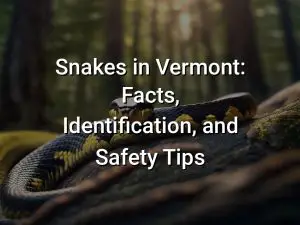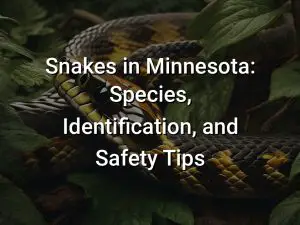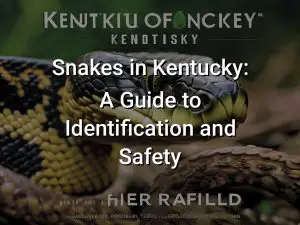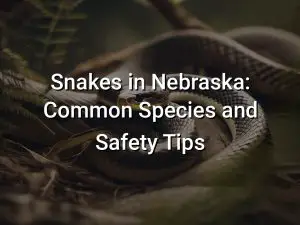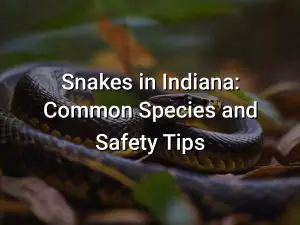The Presence of Snakes in Iowa: Facts and Safety Measures
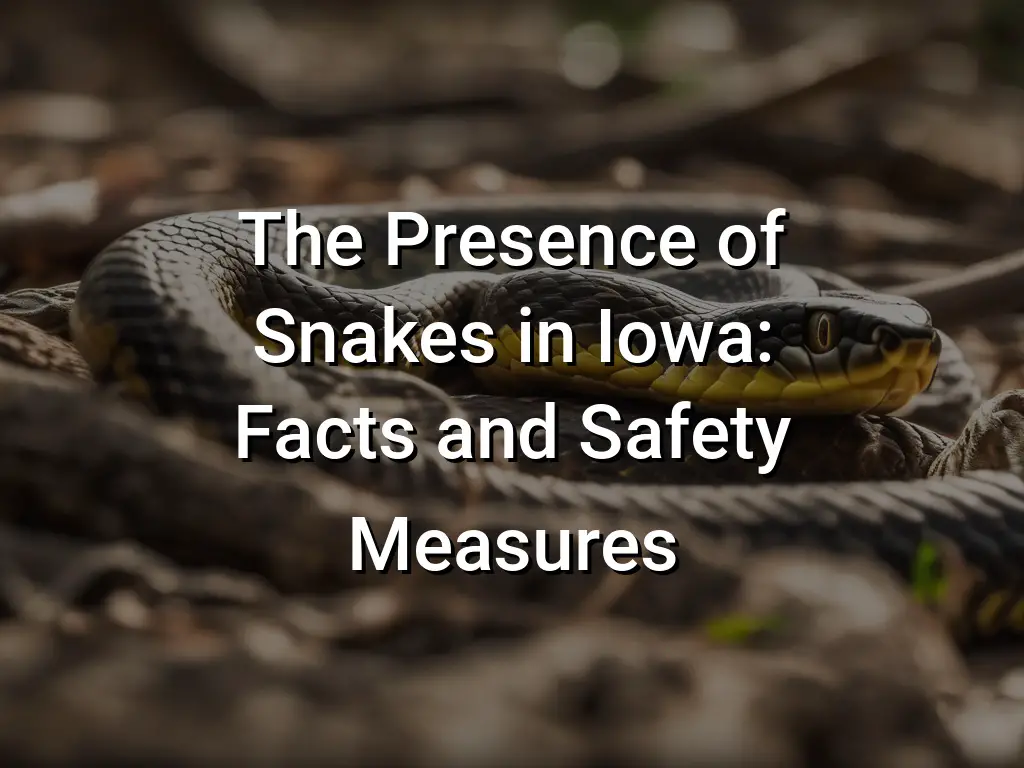
Iowa may not be the first state that comes to mind when you think of snakes, but these fascinating creatures can indeed be found in the Hawkeye State. From harmless species to venomous ones, Iowa is home to a diverse snake population that plays an important role in the ecosystem. In this article, we’ll explore the presence of snakes in Iowa, provide facts about the different types of snakes, and share important safety measures to keep in mind.
From harmless snakes like garter snakes and corn snakes to venomous ones like copperheads and timber rattlesnakes, Iowa has a variety of snake species. It’s important to be able to identify these snakes for your own safety and to promote coexistence. We’ll also debunk some common myths about snakes and share information about snake education, awareness programs, and conservation efforts in Iowa. So, if you’re curious about the world of snakes in Iowa and want to learn how to stay safe and informed, read on!
Quick Links
Types of Snakes in Iowa
Iowa is home to a variety of snake species, both harmless and venomous. It’s important to be aware of the different types of snakes you may encounter to ensure your safety and avoid any unnecessary fear or harm.
Here are some common types of snakes found in Iowa:
- Garter Snakes: Garter snakes are one of the most common snake species in Iowa. They are harmless and play an essential role in controlling rodent populations.
- Bullsnakes: Bullsnakes are non-venomous snakes that closely resemble rattlesnakes. Although they may hiss and strike as a defensive mechanism, they are not harmful to humans.
- Eastern Hognose Snakes: Eastern hognose snakes are known for their upturned nose and defensive behavior. They often display a dramatic bluff, but they are not venomous and pose no threat to humans.
- Red-Bellied Snakes: Red-bellied snakes are small and have a red or orange belly. They are harmless and mainly feed on earthworms and small invertebrates.
- Timber Rattlesnakes: Timber rattlesnakes are the only venomous species of snake found in Iowa. They are rare and usually found in the eastern part of the state. If you encounter a timber rattlesnake, it’s crucial to give it a wide berth and contact local authorities for proper removal.
Remember, it’s always best to avoid handling or approaching snakes in the wild. Most snakes are not aggressive and will only bite if they feel threatened or cornered. If you encounter a snake, maintain a safe distance and observe it from afar.
Harmless Snakes
In Iowa, there are several species of snakes that are harmless and pose no significant threat to humans. These snakes play important roles in maintaining the ecological balance of their habitats.
- Garter snakes: Garter snakes are one of the most common snakes in Iowa. They are typically small and slender and have distinct longitudinal stripes along their bodies. Garter snakes are non-venomous and mainly feed on small invertebrates.
- Brown snakes: Brown snakes are small and secretive snakes. They are usually found in moist habitats like gardens and wooded areas. Brown snakes are harmless and help control pests like slugs and snails.
- Ring-necked snakes: Ring-necked snakes are named for the bright yellow or orange ring on their necks. These snakes are docile and rarely bite. They mainly feed on small reptiles and amphibians.
It’s important to remember that although these snakes are harmless, it’s best to observe them from a safe distance and avoid handling them. If you encounter a snake and are unsure of its species, it’s always a good idea to contact a local wildlife authority for assistance.
Venomous Snakes
While Iowa is home to several species of snakes, there are only four venomous snakes found in the state. It’s important to be able to identify these venomous snakes to ensure your safety and take appropriate precautions.
The four venomous snakes in Iowa are:
- Prairie Rattlesnake – The prairie rattlesnake is the only venomous snake species that is native to Iowa. They can be found in the western and southwestern parts of the state. Prairie rattlesnakes have a distinctive rattle on their tail and should be avoided if encountered.
- Timber Rattlesnake – Although the timber rattlesnake is considered a rare species in Iowa, they can be found in the southeastern part of the state. Like the prairie rattlesnake, they have a rattle on their tail and should be avoided.
- Copperhead – The copperhead is a venomous snake that is found in the southeastern part of Iowa. They have distinctive copper-colored heads and hourglass-shaped markings on their bodies. Copperheads are generally not aggressive but may bite if threatened.
- Eastern Massasauga Rattlesnake – The Eastern Massasauga rattlesnake is a small and rare venomous snake found in some parts of eastern Iowa. They have rattles on their tail and should be avoided if encountered.
It’s important to note that snakes generally avoid contact with humans and will only bite if they feel threatened. If you encounter a venomous snake, it’s important to keep your distance and give it space to retreat. Do not try to handle or capture the snake. If you are bitten by a venomous snake, seek medical attention immediately.
It’s also worth mentioning that the majority of snake bites in Iowa are from non-venomous snakes, which may cause discomfort but are generally not life-threatening. However, it’s always wise to take precautions and educate yourself about the snakes in your area to ensure your safety.
Snakebite Safety Measures
While encountering a snake in Iowa is relatively rare, it’s essential to know some safety measures in case of a snakebite. Remember that most snakes found in Iowa are non-venomous, and snakebites are uncommon. However, in the event of a snakebite, here are some important steps to take:
- Stay calm: Try to remain calm and avoid panicking. Panicking can increase your heart rate, which can speed up the spread of venom if the snake is venomous.
- Move away from the snake: Slowly and carefully move away from the snake’s vicinity to reduce the risk of further bites.
- Seek medical help: Even if you’re unsure whether the snake is venomous or non-venomous, it’s crucial to seek immediate medical attention. Call emergency services or go to the nearest hospital.
- Keep the affected area still: If possible, immobilize the limb or body part that was bitten. Avoid unnecessary movement that could hasten the spread of venom.
- Remove constrictive items: If it doesn’t require much movement, remove any constrictive items like jewelry or clothing from the affected area. This step might be helpful if the area starts to swell.
- Clean the wound: Gently clean the bite wound with soap and water, but avoid applying any substances like alcohol or antiseptics, as they can potentially harm the affected area.
- Don’t suck out the venom: Contrary to popular belief, it’s not recommended to suck out the venom from a snakebite. It can worsen the wound and introduce bacteria or infection.
- Do not apply a tourniquet: Similarly, avoid applying a tourniquet or constricting bandages above the bite site. It can lead to further complications and cause tissue damage.
- Take note of snake characteristics: If possible, try to remember the snake’s appearance and characteristics, such as the size, color, and any identifiable patterns. This information can help medical professionals determine the appropriate treatment.
- Follow medical advice: Once you reach medical professionals, follow their advice and instructions. They will evaluate the bite and provide the necessary treatment.
Remember, prevention is key when it comes to snakebites. Avoid provoking or approaching snakes in their natural habitats, wear protective clothing and boots when hiking or gardening, and remain vigilant in areas known for snake activity. By taking these precautions, you can minimize the risk of snakebite incidents.
Snake Identification Tips
Knowing how to identify snakes is essential for understanding their behavior and potential risks. Here are some snake identification tips to help you differentiate between the different species:
- Look at the color and pattern: Snakes in Iowa display a wide range of colors and patterns. Some common patterns include rings, blotches, or stripes. Pay attention to the color of the snake’s scales as it can vary from brown and gray to green or black.
- Observe the head shape: Venomous snakes in Iowa typically have a triangular-shaped head, while non-venomous snakes have a more rounded or oval-shaped head.
- Check the eye shape: Venomous snakes often have elliptical-shaped pupils, similar to that of a cat. Non-venomous snakes usually have round pupils.
- Consider the body shape: Venomous snakes tend to have a heavier, thicker body compared to non-venomous snakes. Non-venomous snakes generally have a slender and more streamlined body.
- Look for other distinctive features: Some snake species have specific markings or features that can help with identification, such as a rattlesnake’s rattle or a coral snake’s red and yellow bands.
Remember, it’s important to exercise caution when identifying snakes. If you are unsure about a snake’s species or whether it is venomous, it’s best to keep your distance and contact a professional for assistance.
Snake Prevention Tips
Preventing encounters with snakes is important for ensuring your safety and the well-being of the snakes themselves. Here are some tips to help you prevent snakes from entering your property:
- Keep your yard clean: Remove any debris, such as leaf piles, wood piles, and tall grass, as these can attract snakes and provide them with hiding spots.
- Maintain a well-maintained yard: Trim shrubs, bushes, and overgrown vegetation regularly to eliminate potential hiding places for snakes.
- Seal gaps and cracks: Inspect the exterior of your house for any gaps or cracks and seal them properly to prevent snakes from entering your home.
- Install snake-proof fencing: If you live in an area with a high snake population, consider installing snake-proof fencing around your property to keep them out.
- Keep food sources away: Store pet food, bird seed, and trash in secure containers or areas that are inaccessible to snakes.
- Clear away potential snake shelters: Remove rocks, logs, and other potential snake shelters from your property to discourage them from taking up residence.
- Be cautious when gardening: Be mindful of snakes when gardening, especially when reaching into dark areas or under rocks, as snakes may be hiding there.
By following these preventative measures, you can minimize the likelihood of encountering snakes on your property and reduce the risk of snake bites. Remember, snakes play an important role in the ecosystem, so it’s important to respect them and take appropriate precautions rather than resorting to unnecessary harm or eradication.
Snake Removal Services
When encountering snakes in and around your property in Iowa, it is important to know that there are professional snake removal services available to assist you. These services are equipped with the knowledge and tools to safely and effectively remove snakes from your property while minimizing harm to the snakes and ensuring your safety.
Snake removal services employ trained professionals who can identify different snake species and determine the best course of action for removal. They have the necessary tools and techniques to safely capture and relocate snakes to their natural habitats without causing harm to the snakes or the environment.
It is important to remember that attempting to remove snakes on your own can be dangerous and should be avoided. Snakes can be unpredictable, and some species are venomous, posing a potential threat if mishandled. By calling a professional snake removal service, you can ensure that the situation is handled safely and responsibly.
Additionally, snake removal services can also provide valuable guidance on how to prevent snakes from entering your property in the future. They can identify potential entry points and recommend measures to make your property less attractive to snakes, such as sealing gaps in walls or foundations, removing clutter that can provide hiding spots, and keeping your yard well-maintained.
If you encounter a snake on your property in Iowa, it is advisable to contact a reputable snake removal service. They can assist you in safely resolving the situation and help you take preventative measures to reduce the likelihood of future snake encounters.
Snake Conservation Efforts
As snakes play an important role in ecosystems, there are ongoing efforts in Iowa to conserve and protect snake populations. These efforts are aimed at maintaining the delicate balance of nature and ensuring the survival of both snake species and their habitats.
One important aspect of snake conservation in Iowa is the preservation and restoration of natural habitats. By protecting and maintaining suitable habitats, such as wetlands and prairie grasslands, the native snake species in Iowa can thrive. This includes efforts to control invasive species, manage land use, and limit the destruction of critical habitats.
Education and awareness programs are also a crucial part of snake conservation in Iowa. By educating the public about the important role snakes play in the ecosystem and dispelling common myths and misconceptions, these programs aim to foster understanding and appreciation for snakes. This, in turn, can help reduce the unnecessary killing or injury of snakes.
In addition to education, research plays a significant role in snake conservation efforts. By studying snake populations, behavior, and habitat requirements, scientists and conservationists can gain valuable insights that can inform conservation strategies. The data collected through these studies can help develop effective conservation plans and management practices.
Collaboration between government agencies, conservation organizations, and the public is essential for successful snake conservation in Iowa. By working together, these stakeholders can develop and implement conservation plans, establish protected areas, and promote sustainable practices that benefit both snakes and the environment.
Overall, these conservation efforts are essential for preserving the diverse snake species in Iowa and ensuring the health and balance of the state’s ecosystems. By valuing and protecting snakes as an integral part of the natural environment, Iowa can contribute to the conservation of these fascinating and often misunderstood creatures.
Myths About Snakes
Snakes have long been the subject of myths and misconceptions, often leading to fear and misunderstanding. It’s important to separate fact from fiction when it comes to these fascinating creatures. Here are some common myths about snakes debunked:
- Snakes are slimy: One of the most common misconceptions about snakes is that they are slimy. In reality, snake scales are smooth and dry to the touch. Their scales help them move easily across various terrains and provide protection.
- All snakes are venomous: While there are venomous snakes, not all snakes are venomous. In fact, the majority of snake species are non-venomous. It’s important to educate yourself about the types of snakes in your area to determine whether they are harmful or harmless.
- Snakes chase people: Another common myth is that snakes will chase people. Snakes are generally shy and will try to avoid human interaction. They are more likely to retreat and hide when they feel threatened.
- Snakebites are always deadly: While snakebites can be dangerous and require medical attention, not all snakebites are deadly. The severity of a snakebite depends on various factors, including the species of snake, the amount of venom injected, and the location of the bite.
- Snakes are aggressive: Snakes are not typically aggressive unless they feel threatened or cornered. Most snakes will try to escape rather than confront humans or other animals. It’s important to give snakes their space and not provoke them.
- Snakes can hypnotize their prey: There is a myth that snakes can hypnotize their prey, such as birds or rodents. This is not true. Snakes use various methods to catch their prey, such as ambush or constricting.
By understanding the truth about snakes and dispelling these myths, we can foster a greater appreciation for these important creatures and coexist with them safely.
Snake Education and Awareness Programs
Snake education and awareness programs play a crucial role in educating the public about the presence of snakes in Iowa and promoting safety measures. These programs aim to dispel myths and misconceptions about snakes and provide accurate information to help people coexist with these reptiles.
Many state and local organizations, nature centers, and wildlife agencies offer snake education programs. These programs often include educational presentations, workshops, and guided snake hikes to teach people about the various snake species found in Iowa, their habitats, behavior, and importance in the ecosystem.
Snake education and awareness programs also focus on teaching people how to identify venomous snakes and differentiate them from harmless species. Participants learn about the physical characteristics and behaviors that can help distinguish venomous snakes, such as the presence of a triangular-shaped head, vertical pupils, and rattles on the tail.
Additionally, these programs emphasize snakebite safety measures and first aid protocols. Participants are educated on how to prevent snakebite incidents, what to do in case of a snake encounter, and when to seek medical attention after a bite.
Snake education and awareness programs also play a crucial role in dispelling common myths and fears associated with snakes. By providing factual information and addressing misconceptions, these programs help people develop a better understanding and appreciation for these fascinating reptiles.
Overall, snake education and awareness programs are essential for promoting coexistence with snakes in Iowa. By increasing public knowledge and dispelling fears, these programs help create safer environments for both humans and snakes.
Conclusion
Now that you have a better understanding of the presence of snakes in Iowa, it’s important to take the necessary safety measures when encountering them. Remember that not all snakes in Iowa are venomous, and many of them are harmless and play a vital role in our ecosystem.
By familiarizing yourself with snake identification tips and prevention measures, you can minimize the risk of snakebites and coexist safely with these reptiles. If you do encounter a snake and feel unsure about how to handle it, it’s best to contact professional snake removal services for assistance.
Lastly, educating yourself and others about snakes and dispelling common myths can help promote conservation efforts and foster a greater appreciation for these creatures. By working together to raise awareness and understanding, we can ensure the safety of both humans and snakes in Iowa.
Stay safe and enjoy the beauty of Iowa’s natural wildlife!

